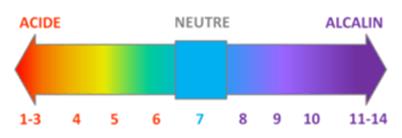PH from the water, let's talk about it!
Water pH, Quesaco? What is it used for?
The pH of water refers to the measurement of the hydrogen potential and in particular the hydrogen ion concentration of your water. If you are a novice in this field, you should know that the ideal pH is between 1 and 14. Drinking water has a pH of 7 while tomato juice has a pH between 4 and 4.5. A pH below 7 is said to be acidic and above 7 is basic, i.e. with a more calcareous flavour.

What is the right pH level and how to obtain it?
The pH is a measurement that can be calculated with the help of simple equipment such as strips, drops and electronic meters. In previous blogs we have indicated that the correct pH value for water is between 7 and 7.4. To find this right balance, it is essential to check this pH value once or twice a week. The proposed treatment products are also designed to have the right pH level.
Calculation of the pH of the water with the ideal value
Easy-to-use tools are used to calculate pH. For example, drops, electronic meters or test strips. The pH can also be calculated manually or with an automatic pH regulator. For pool owners, the ideal pH value should not exceed 7 to 7.4. It is necessary to check it at least twice a week to avoid making the water too acidic or too basic. This margin is respected regardless of the water treatment product used, with the exception of bromine, which can reach a level of 7.6. This pH level determines the quality of your water whether you use a shock treatment (against green water) or a maintenance treatment. For those who are used to using chlorine, this product offers a 100% efficiency at a pH level around 5 making the water acidic and unsuitable for swimming. Its efficiency is 60% to obtain the ideal value between 7 and 7.4, and 30% with a pH of 7.8.
PH low, high or unstable? Follow the tips of a pro to solve the problem!
Low PH
A low pH is equivalent to very acidic water, which is harmful to you and your pool materials. This acidic quality also blocks the action of the treatment, which could lead to the proliferation of algae and limescale that clog the filtration. What should be done to remedy this acidic water? First of all, the pH level must be checked at least every 2 days to correct the pH margin, then the filter must be cleaned. The next step is to supplement the required dose with the PH plus ,and then run your pool in recirculation mode as indicated on the back of the product. Finally, the pH must be checked again and the operation repeated if necessary. If the pH is at the right level, you can now bathe in the water without forgetting to check the pH every two days.
High PH
In general, pool owners are often confronted with high pH, which results in alkaline water that is harmful to the skin. There are many causes for this high pH, including rising temperatures, stormy weather, plants and trees around the pool sending their foliage and pollen into the water, and so on. Having alkaline water hinders the effectiveness of water treatments, causing the subsequent development of limescale and algae that can clog the filtration system. So what can be done? When the water is alkaline, the pH level must always be checked at least every 2 days. It should be noted, however, that correcting the pH variation is slow and complicated. So, it is advisable to clean the filter and then add the required dose of PH minus according to the indication on the back of the product. To finish, we invite you to follow the same step as for Low pH.
Unstable PH
Unstable pH is caused by a low TAC, making it difficult to bring it back to the right level. The solution is therefore to regulate the alkalinity of the water before managing the Ph calculation. When the TAC is at the right level, you can follow the previous processes to bring the pH back to the right level.
Jade's latest tip for enjoying your summer
Do not neglect the use of an automatic pH regulator to quickly and easily obtain the ideal pH range, i.e. between 7.0 and 7.4. By following the advice given, you will be sure to maintain the correct pH for water suitable for swimming. In closing, thank you for taking the time to read these articles. I hope they will be of great help in enjoying an unforgettable summer on the water. See you soon for a new article. Your best advisor, Jade.
